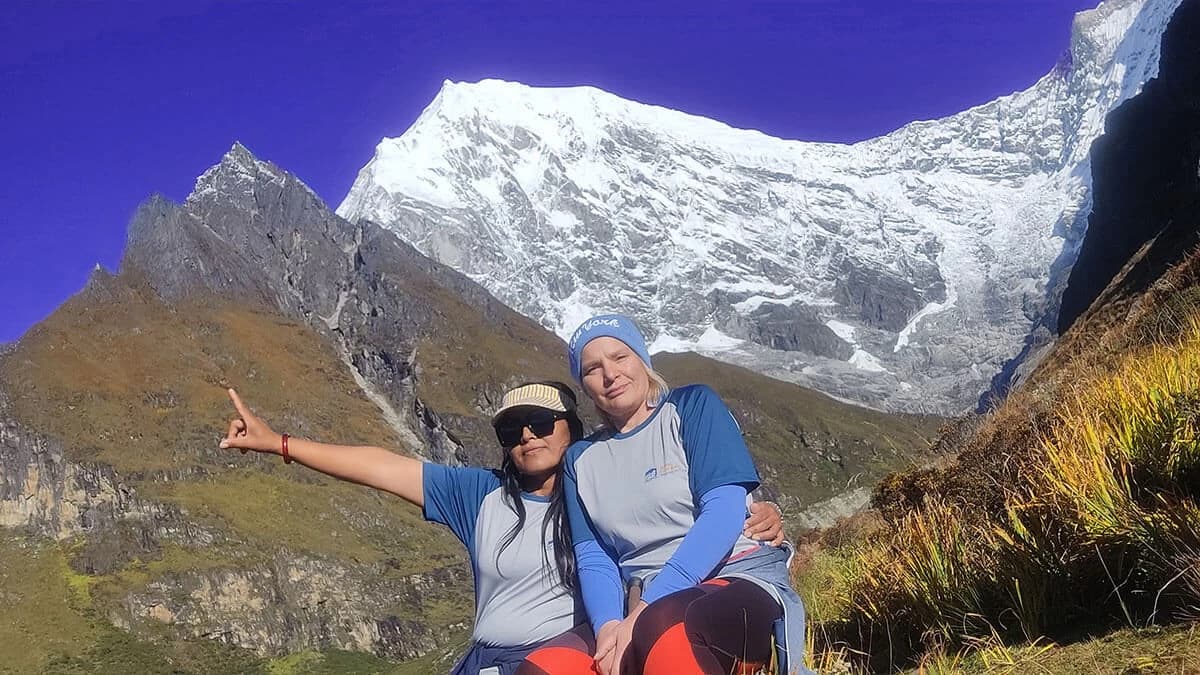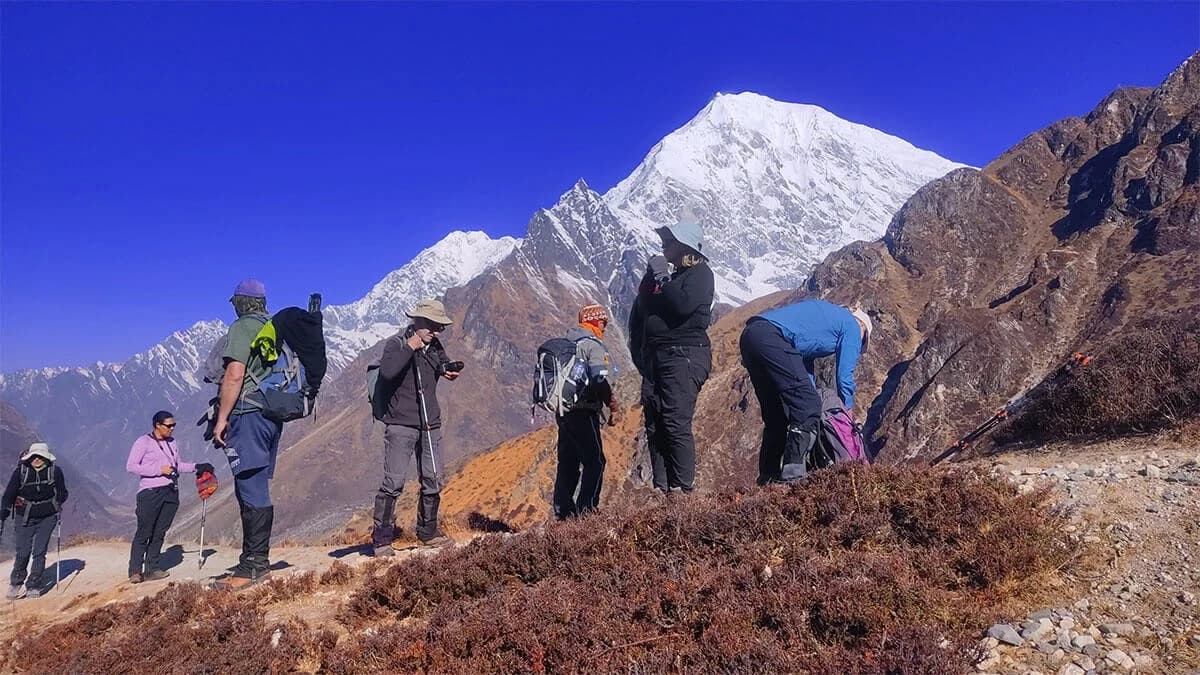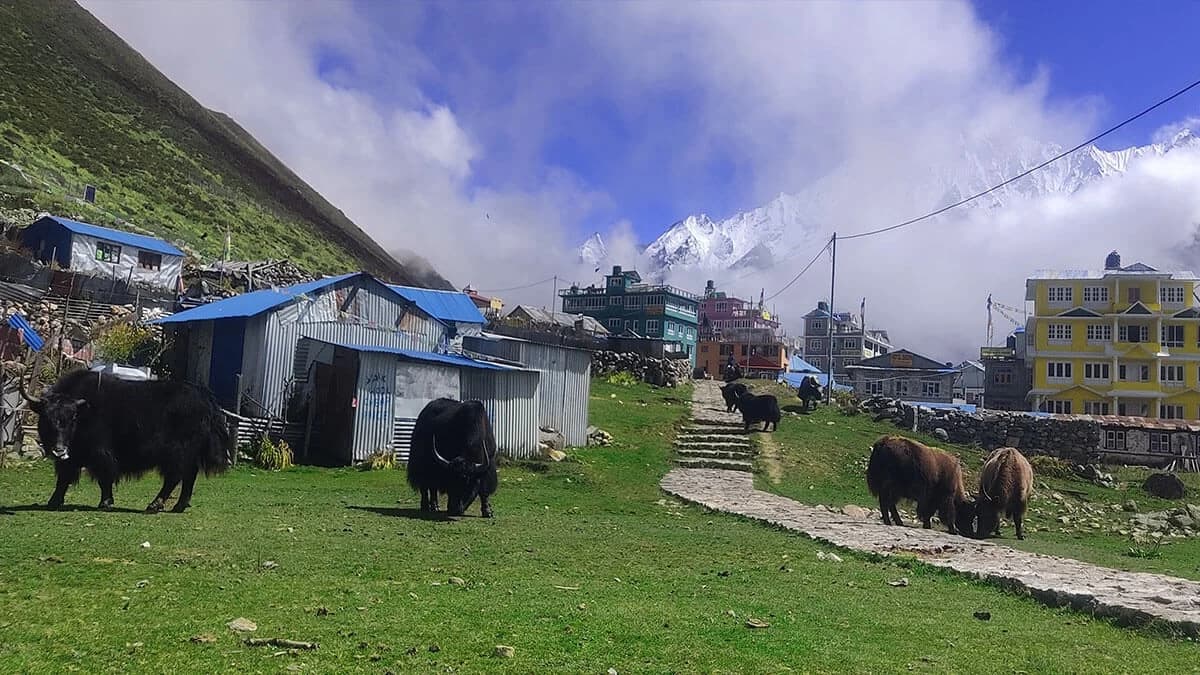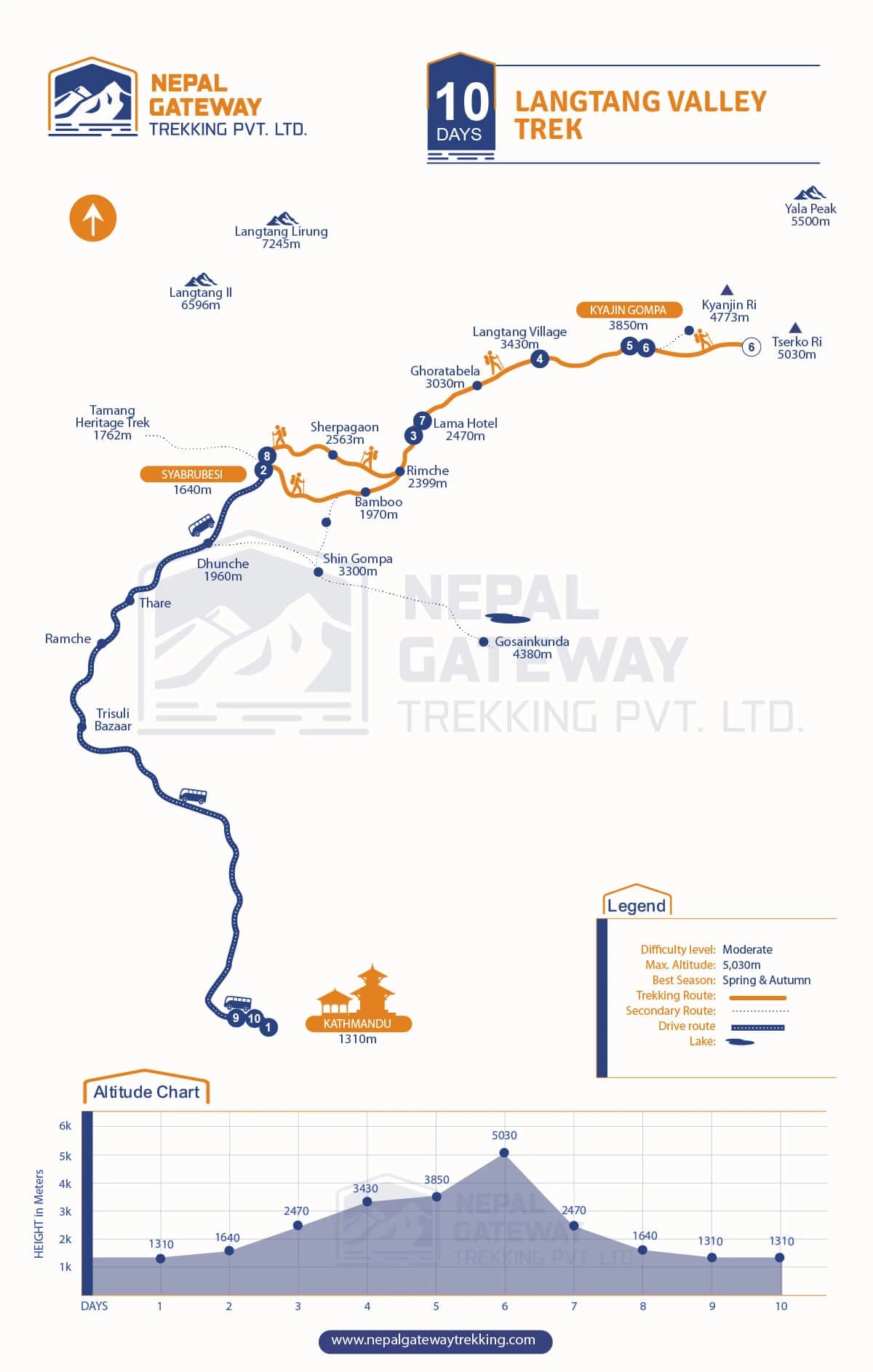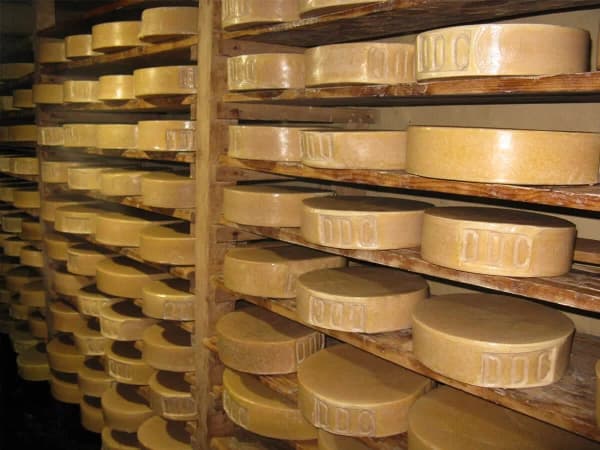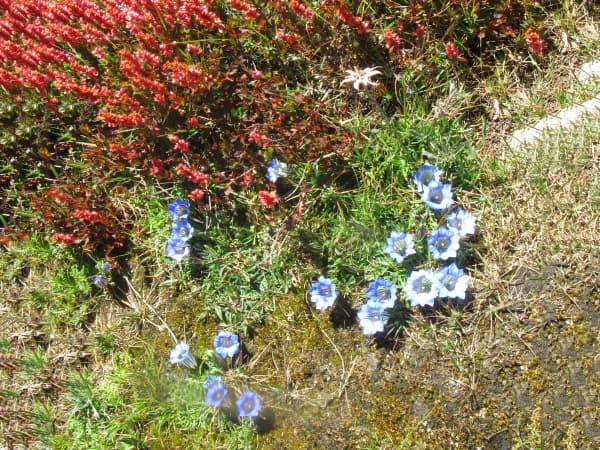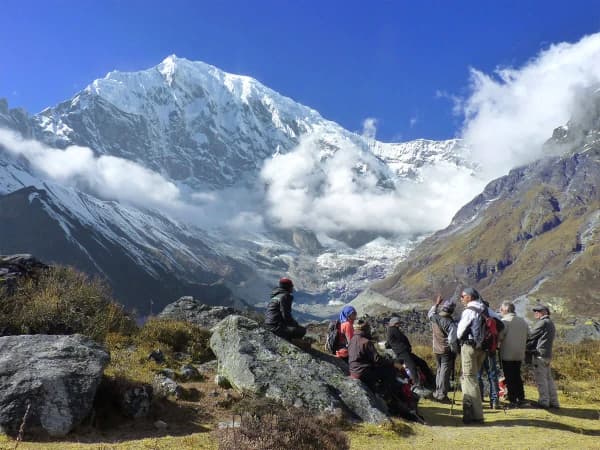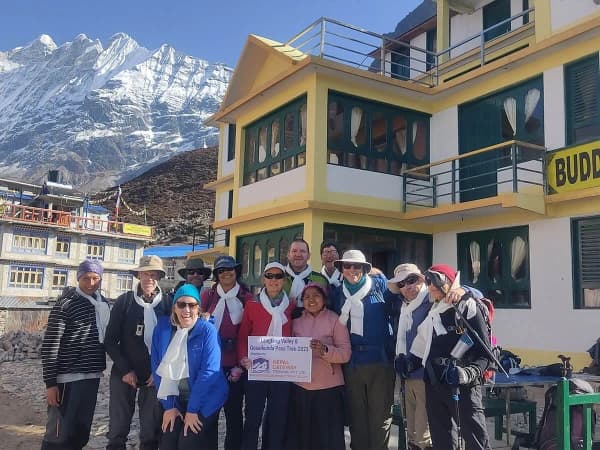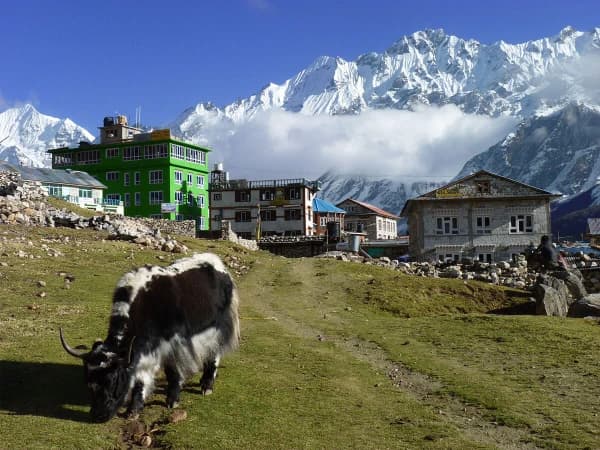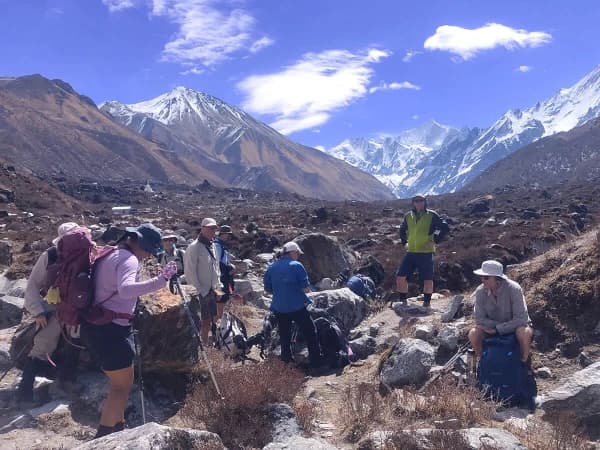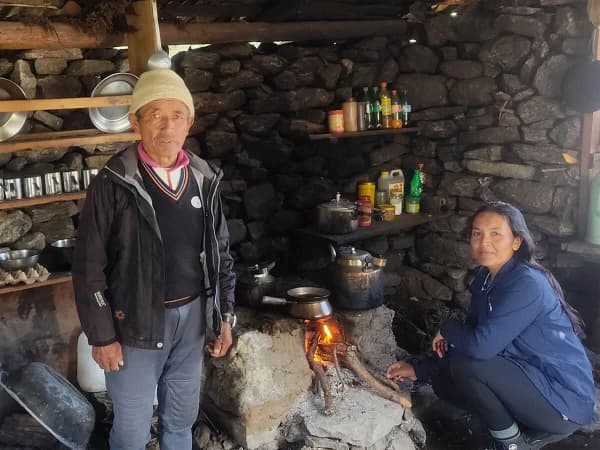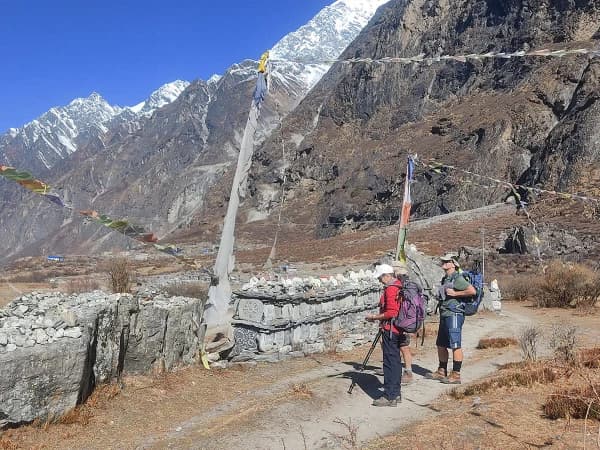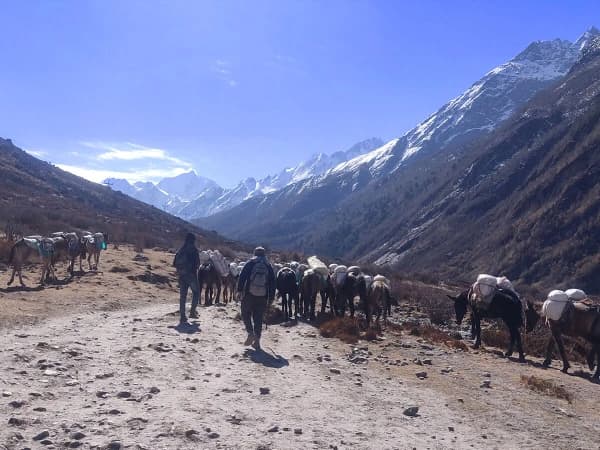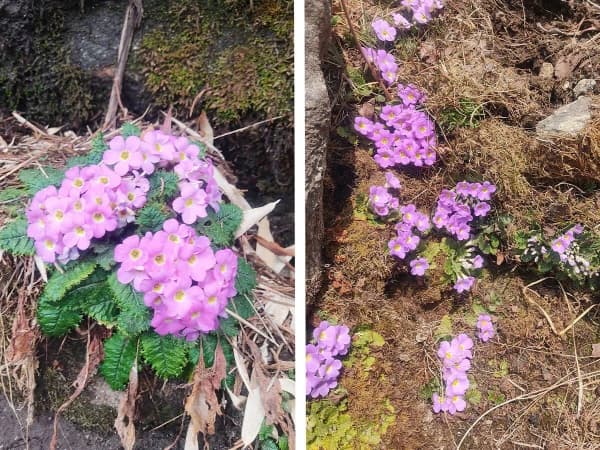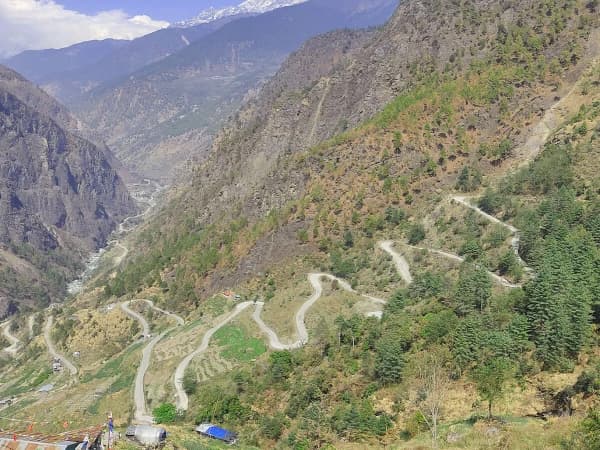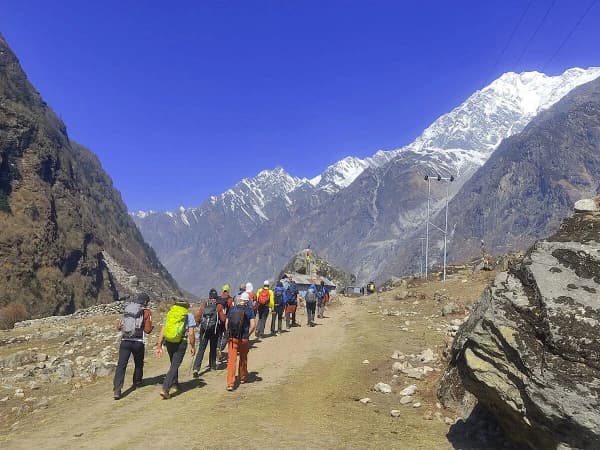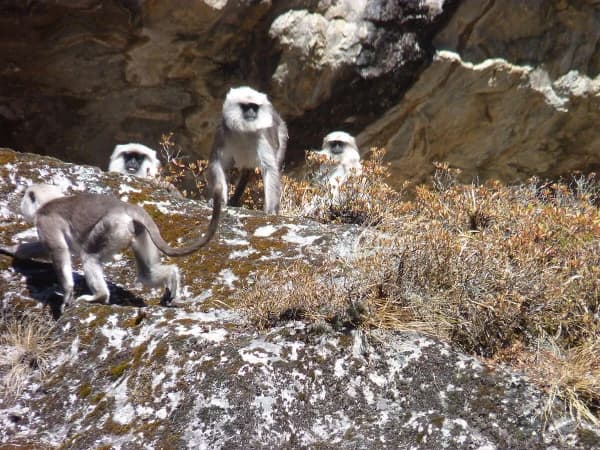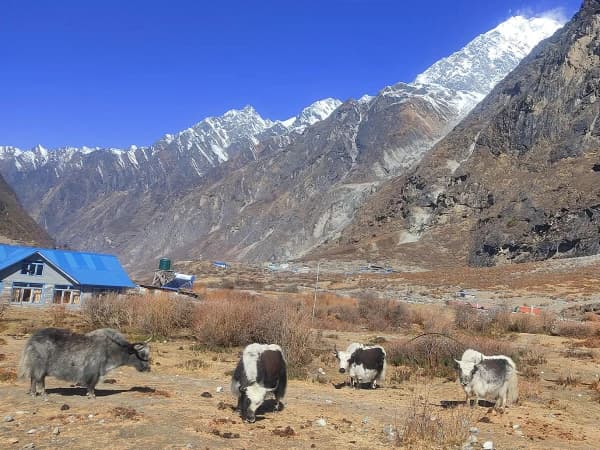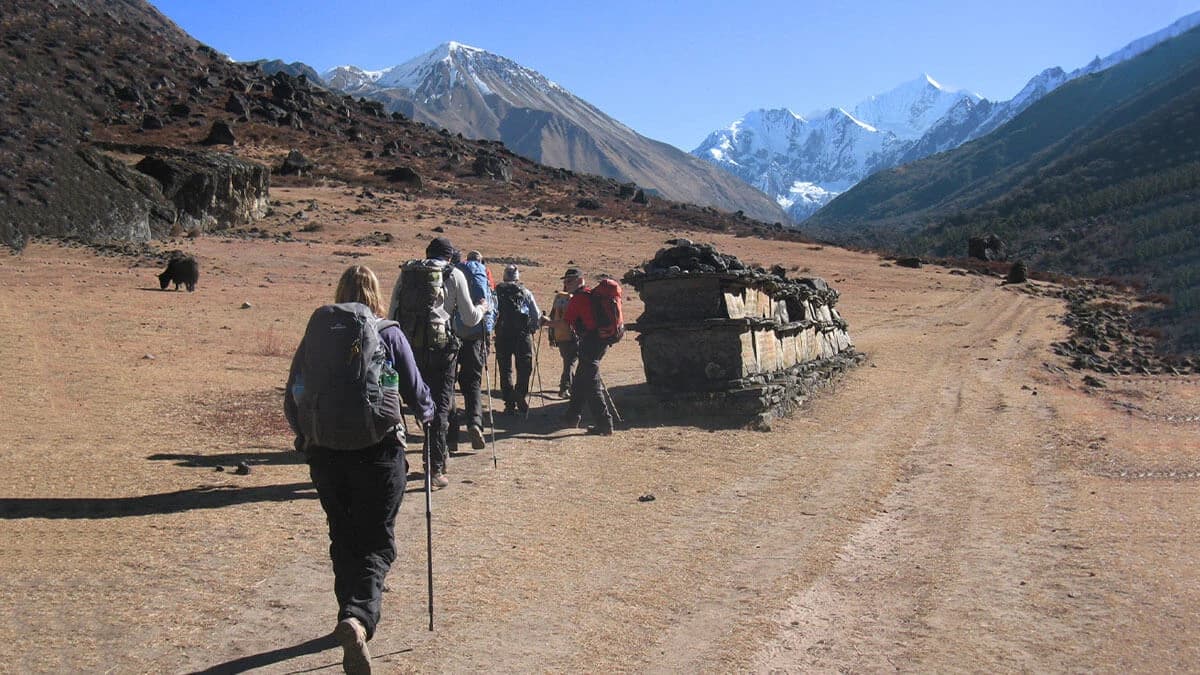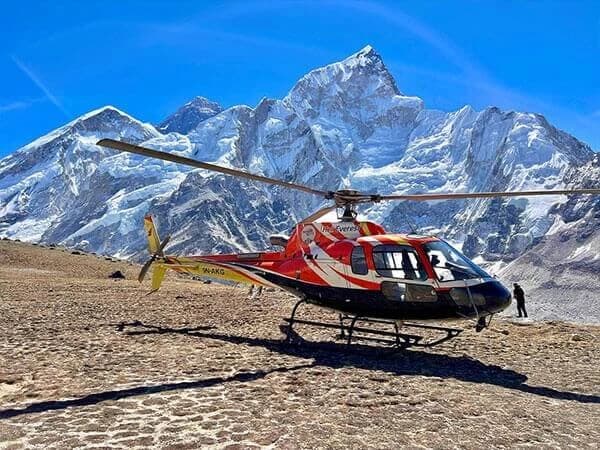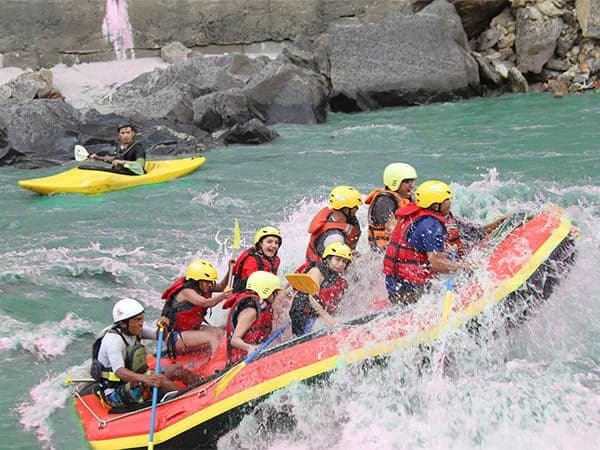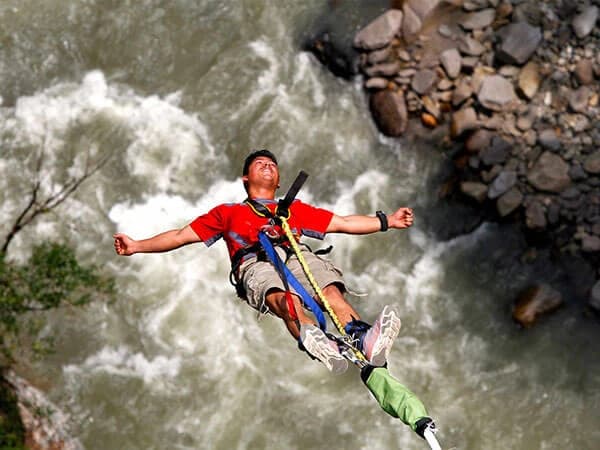The Langtang Valley Trek is a supreme experience of natural beauty and cultural enrichment for every trekker around the world.
Langtang Valley Trek
Langtang Valley Trek is one of the most famous hiking routes in Nepal, among other trekking trails. It is located in the Langtang region. Unlike the famous Everest Base Camp Trek and Annapurna Base Camp Trek, the Langtang Valley Trek follows relatively moderate terrain.
Langtang Valley is a part of Langtang National Park. The park is listed as a world heritage natural site. The Langtang National Park is famous for rare indigenous species such as the red panda. It is also home to humid forests and a variety of flora.
If you are a nature and wildlife lover, the Langtang Valley Trek is a remarkable trip. The trek also provides an opportunity to see the incredible scenery of the snow-roofed peaks of the Langtang range. The views of Langtang Lirung, Ganesh Himal, Dorje Lakpa, Gang Cheenpo, Naya Kangri, Yala Peak, and Loenpo Gang are spectacular.
The Langtang Valley Trekking is suitable for everyone and doable for children with families, couples, and adults. The trek does not ask for any previous trekking experience. You can do it as long as you are physically fit and able to walk for 5-7 hours a day in high-altitude terrain.
The Major Highlights of Langtang Valley Trekking
- Quick access to the starting point of the trek.
- Explore Langtang National Park.
- Walk through lovely villages and get to see the lifestyle of mountain people.
- The trail crosses suspension bridges and gorgeous waterfalls.
- Enjoy fantastic mountain views and landscapes.
- Come across a range of flora and fauna while passing by dense forests.
- Numerous mani walls, chortens, prayer wheels, and stupas along the way.
- Visit the ancient Kyanjin Gompa and catch a breathtaking sunrise from Tserko Ri.
Langtang Valley Route Overview
The Langtang Valley Trek starts upon your arrival at Kathmandu Airport. We pick you up and arrange all the necessary documentation for the trip before you leave Kathmandu. You drive to Syabru Besi, the starting point of the trek. You'll walk through dense rhododendrons and bamboo forests to alpine meadows to reach Kyanjin Gompa.
On the first day of your hike to Langtang Valley, you'll follow the Langtang River and pass Bamboo to reach the Lama Hotel. The trail to Lama Hotel from Syabru Besi is not very good, so you must be careful when hiking. You'll have to walk on a narrow trail and sometimes on the landslide sections where the small moving rocks make it hard to pass.
The following day, you'll continue your journey to reach Langtang village. The trail offers excellent views of the mountains. If you are lucky, you can see the musk deer and red panda while walking through the forest. Langtang is a village that was hugely destroyed in the earthquake of 2015.
After breakfast in the morning at Langtang Village, you'll walk and pass mani walls and chortens to reach Kyanjin Village. Today is the most leisurely day of trekking to Langtang Valley. You can explore the centuries-old monastery, Kyanjin Gompa, in the afternoon as an acclimatization hike. Visiting the cheese factory in the town is an extra activity.
The following day, you'll hike Tserko Ri (5,030 m) in the early morning with a packed lunch. The hike to Tserko Ri is challenging because it is climbing and takes 6-7 hours round-trip. You will be rewarded with breathtaking views of the Langtang range and surrounding peaks with their greenery. Then, you'll trace the same trail to Syabru Besi and catch a bus to Kathmandu.
Langtang Valley Trekking Package and Cost for 2025
We are a local-based trekking agency in Nepal with many years of trekking experience in the Himalayas. So there is no commission to pay anyone. We have made the best itinerary for the Langtang Valley Trek Package 2025 to explore the Langtang region. Our itinerary covers what you can expect from the Langtang Trek.
We have offered the best price and guaranteed departure for the Langtang Valley Trekking Package 2025. If you travel in a group, we offer a discounted price for the Langtang Trek. Depending on the group size, you'll get a discount of USD 60 to USD 120 per person.
Our Langtang Trek package 2025 covers the accommodation in Kathmandu and complimentary pick-up and drop-off. It also includes the necessary permit for the trek in Langtang, your meals, and lodging for the trek. A highly experienced trekking guide and required porters will be assigned, too. Our professional team and friendly trekking guide put in their effort to make the journey mesmerizing and hassle-free.
Langtang Valley Trek Cost Breakdown
The price for the Langtang Valley Trek starts at US$760 per person, but the final cost varies depending on the size of your trekking group. Here’s how the pricing works:
- Solo Trekker (1 person): US$760
- Small Group (2 to 4 people): US$700 per person
- Medium Group (5 to 10 people): US$660 per person
- Large Group (11 to 16 people): US$640 per person
Booking as a group helps reduce the cost per person, making the trek more affordable when you travel with friends or family.
This price usually includes accommodation in teahouses along the route, all meals during the trek, permits, transportation to and from the trailhead, experienced guides, and support staff.
Permits Required for Langtang Valley Trek
The Langtang National Park Entry Permit and a TIMS (Trekkers’ Information Management System) card are the two primary permits required to trek in the Langtang region. Additional licenses can be needed if you intend to continue your journey to places like Gosaikunda or Helambu.
Langtang National Park Entry Permit
- Foreign Nationals: NPR 3,000
- SAARC Nationals: NPR 1,500
- Nepali Citizens: NPR 100
- Children under 10: Free
Where to Get It: Nepal Tourism Board (Kathmandu) or at the Dhunche checkpoint
TIMS Card (Compulsory for All Trekkers)
- Foreign Nationals: NPR 1,000
- SAARC Nationals: NPR 300
Where to Get It: Only through a government-registered trekking agency
Local Entry Fee (May Apply)
Some rural municipalities in Rasuwa District may charge an additional local tax at trail checkpoints.
- Fee: NPR 200–500 (in cash)
- Where to Pay: At Syabrubesi or Dhunche
Where to Obtain the Permits?
You can receive the necessary permits in Kathmandu or at the Dhunche checkpoint. However, it is strongly advised to secure these prior to beginning your expedition. Trekking agencies usually handle this for you, making things smoother and more efficient.
Do you intend to explore further?
If your journey involves Gosaikunda or Helambu, check ahead of time to see if any additional permits are required. Local rules can change, so it’s always best to double-check with your guide or trekking company before departure.
Need Help?
If you’re not sure about which permits you’ll need based on your route, don’t worry. Nepal Gateway trekking will help you sort it all out before you start. Just bring your passport, a few passport-sized photos, and enjoy the journey.
Itinerary
This is our standard and recommended Langtang Valley Trek itinerary.
You will meet one of our teams at the Kathmandu airport on your arrival. They will be outside the arrival terminal with your name. After a warm welcome, they will take you to the hotel and assist with check-in.
You meet one of our managers in the evening. He will brief the program in detail and reach for your needs. Settle the payment and other formalities, introduce your trekking guide, and let him help you check your belongings.
Your trekking guide will meet you at the hotel in the morning. Then you drive to Syabru Besi by local express bus. It is 7-8 hours drive. The drive offers captivating views of mountains, terraced fields, and small villages. You reach Syabru Besi, passing Dhunche. Dhunche is headquartered where your permits will be checked.
The trek begins today. After your breakfast, you walk along the Langtang River. You will be ascending through lush forests and terraced fields. The trail goes through remote villages and reaches Rimche (2,400 m). Further, walking by dense bamboo forests, you walk along the bank of the Langtang River to reach the Lama Hotel.
Today you start a trek with a short climb to the ridge. You walk through a dense forest of rhododendrons and oaks. The trail mostly ascends through dense forests to reach Ghoda Tabela (3,030 m). From here, you walk through passing water mills, mani walls and chortens, and prayer wheels to reach Langtang village.
Today is one of the easy trekking days of the Langtang Valley trek. It is a short and pleasant walking day. The trail mostly leads gradually to the Kyanjin Gompa Village. You pass small plateaus, yak pastures, mani walls, meadows, and remote settlement areas to reach Kyanjin village.
There is an ancient and century-old monastery in Kyanjin Village; it is called Kyanjin Gompa. After lunch, you can visit the monastery, the cheese factory, and the Kyanjin village in the afternoon.
Today is a tough hiking day. You wake up early in the morning to hike to Tserko Ri to witness a glorious sunrise along with breathtaking views of the mountains like Langtang Lirung, Langtang II, Ganesh Himal, Mt. Kang Guru, etc. You hike Tserko Ri with a packed lunch and enough water. The hike is around 6-7 hours, and it is a steep climb.
For the next two days, you're going to retrace the route and descend to the point from where you started the journey. From Kyanjin Gompa, you trek down the same route to Lama Hotel via Langtang village and Ghoda Tabela.
Today is the last day of the trek, so enjoy as much as you can. It will be an easy downhill walk to Syabru Besi, although there is some steep climbing section too. Further, the route descends through lush bamboo forests and birch to the beautiful river valley.
Today you drive back to Kathmandu. It's your last day in Kathmandu, so spend the rest of the day doing things you want to do.
Today we say goodbye to you until your next trip to Nepal. Our team will assist with check-out and drop you off at the airport.
Dates & Availability
Private tripCost Includes
- Complimentary airport pickups and drop-offs.
- All ground transportation as per the program.
- Two nights' accommodation in Kathmandu, including breakfast.
- Your three meals (breakfast, lunch, and dinner) during the Langtang Valley Trek.
- Twin-sharing accommodations during the trekking.
- A highly experienced, well-trained, English-speaking trekking guide.
- Required porters and their expenses (1 porter between 2 trekkers). Porter is not included for solo trekkers.
- Langtang National Park permit.
- TIMS card (Trekkers Information Management System). Please bring two passport-size photos.
- Langtang Valley Trekking Map.
- Nepal Gateway Trekking Company T-shirt.
- Nepal Gateway Trekking Company duffle bags for trekking.
- Fresh local fruits (apples, oranges, pears, pomegranates, etc.) as dessert.
- First aid kit with an oximeter to check heartbeats and oxygen levels.
- Emergency rescue assistance if it is necessary.
- All government taxes.
- Office service charges.
Cost Excludes
- Lunches and dinners in Kathmandu.
- Travel insurance.
- International flight tickets to and from Kathmandu.
- Nepal entry visa fee.
- All kinds of hot drinks (tea, coffee, hot water) on the trek.
- Cold drinks (mineral water, Coke, and Fanta) and alcoholic beverages during the trip.
- Your first aid kit, equipment, and items of a personal nature.
- Battery charges for devices (mobile, camera, laptop, etc.) during the Langang hike.
- Snacks and desserts (apple pie, chocolate pie, chocolate bar)
- Tips for trekking staff and drivers. Tipping is expected but not mandatory.
- Extra accommodations in Kathmandu.
Good To Know
What do you see in Langtang Valley Trekking?
The trail to Langtang Valley leads through gorgeous scenery of terraced slopes and dense rhododendron forests. It also passes bamboo forests with alpine pastures sprinkled amidst them. You'll see glacial rivers, waterfalls, and the majestic Langtang range, including Langtang Lirung (7,227m) and Ganesh Himal (7,422m).
The 10-day Langtang Valley Trekking offers gorgeous panoramas of huge glaciers and lovely waterfalls. Along the route, you can see Langtang Lirung (7,234 m), Ganesh Himal (7,422 m), Dorje Lhakpa, Yapa Peak, and numerous others.
The highest point during the Langtang Trek is Tserko Ri (5,030 m). From this point on, the scenery will steal your heart. Every village will bring you a distinct landscape.
The Langtang Trek area is inhabited by Tamang and Tibetans who migrated a long time ago. Tamang is one of the major ethnic groups in Nepal. During the trekking route, you have a chance to interact with the locals and their livelihood in traditional villages. You can learn their cultures, customs, and lifestyles.
The trekking to Langtang Valley passes through Langtang National Park. The park is a habitat for a wide range of wildlife, including red pandas, Himalayan tahr, and langur monkeys.
Flora and Fauna in Langtang Valley Trek
Langtang Valley is part of Langtang National Park, which was established in 1976 and remains one of Nepal’s most important protected areas. The biodiversity here is incredibly rich due to the valley’s elevation range and climate variations.
Forests of pine, oak, and maple dominate the lower parts of the trail. In spring, the hillsides come alive with blooming rhododendrons, Nepal’s national flower. As you ascend, the landscape opens up into high alpine meadows with rare mountain herbs and grasses.
Red Panda Habitat
One of the few places left where the endangered red panda can still be found is Langtang. The dense bamboo forests in the trail's lower sections are home to these timid, tree-dwelling animals.
Even though it's uncommon to see one, the knowledge that they exist—hidden among the trees—brings a sense of silent awe to travels. In addition to being an adventure, your walk will help assist important species conservation because local guides and conservationists work hard to conserve their delicate habitat.
Other Notable Wildlife
Langtang isn’t just about stunning mountain views—it’s a haven for Himalayan wildlife. Here’s what you might encounter along the trail:
- Himalayan Tahr: A wild mountain goat that frequently ascends rugged, steep hillsides.
- Musk Deer: These quick and timid deer are typically seen scurrying through the shadows of the woodland.
- Snow Leopard: Rare and mysterious, this elusive predator quietly roams the higher altitudes.
- Birdlife:
- Himalayan Monal: Nepal’s national bird, known for its vibrant, iridescent plumage.
- Blood Pheasant: A colorful and striking bird often seen in alpine forests.
Every step through Langtang brings you closer to untouched wilderness—where nature still thrives in its raw, unspoiled beauty.
Gosaikunda Lake – A Sacred Detour
For trekkers wishing to extend their journey, Gosaikunda Lake is a fantastic side trip. This mountain lake, located at 4,380 meters, has great religious importance for both Hindus and Buddhists. According to tradition, Lord Shiva created it.
Thousands of pilgrims visit Gosaikunda every year, particularly around the Janai Purnima festival. If you have a few additional days, this journey offers a distinct combination of spirituality and raw mountain beauty. Keep in mind that it takes more time and permissions, but the trip is well worth it.
When is the best time for the Langtang Valley Trek?
Spring (March to May) and autumn (September to November) are the best times for the Langtang Valley Trek. The weather is clear for the views, and the trails are also less influenced by rainfall and snow.
In spring, the forests along the trail come alive with colorful rhododendron flowers, making the scenery especially beautiful. Daytime temperatures are mild, although nights can still be chilly.
Due to the fresh air and clear skies following the end of the monsoon rains, autumn is the most popular time of year for trekking. Walking is made easier and more pleasurable by the dry and secure pathways.
How difficult is the Langtang Valley Trekking Route?
The Langtang Valley Trekking Route is a moderate trekking trail in the Himalayas of Nepal. The trail has ascents and descents. You'll have to walk on steep and rocky sections, too. Climbing Tserko Ri is the toughest part of this trek.
The most important thing is, you will be trekking in a remote area without modern comforts and limited facilities. These things also make the trek to Langtang Valley difficult.
Do I need training for trekking to Langtang Valley?
You do not have to do anything in particular to prepare for 10 days of Langtang Valley Trekking. Any individual can go on the Langtang trek if he or she is in good shape. This trek is friendly for beginners and perfect for new trekkers to test their strength in the Himalayas.
The trek demands a long walk, 5 to 7 hours daily. So, we advise you to work on your stamina and core-body strength before the journey begins. You can regularly do long-distance walking, running, cycling, and swimming at home. In addition to these, you can also do homework in the gym to get more fitness and a better shape for your body.
Syabrubesi – The Trek’s Starting Point
About 120 kilometers north of Kathmandu, in the little village of Syabrubesi, is where your Langtang experience starts. Depending on traffic and road conditions, driving there takes between 6 to 8 hours.
How to Get There
- Private Jeep: The fastest and most comfortable alternative, particularly if traveling in a group.
- Shared Jeep: A more inexpensive option. These normally depart early in the morning from Kathmandu.
- Local Bus: Buses depart from Gongabu Bus Park, however they are slower and more packed.
The road to Syabrubesi winds through terraced hillsides, rivers, and local villages, giving you a taste of rural Nepal before the trek even begins.
Starting the Trek
Most trekkers stay the night in Syabrubesi before setting off the next morning. The trail follows the Langtang Khola (river) and leads you gradually through villages like Lama Hotel, Ghoda Tabela, Langtang Village, and finally Kyanjin Gompa. The route is designed to allow steady acclimatization, which is especially helpful for first-time trekkers.
Travel Tips
Accommodation: You will stay overnight in a lodge or teahouse. The rooms offer basic facilities, twin-sharing beds, and a private or common washroom.
Food: There are many food options, including Western dishes. The tastiest and most filling one is Dal Bhat. It is a traditional meal of Nepal, served with boiled steamed rice, lentil soup, seasonal vegetables, and pickles.
ATM: There is no ATM on the Langtang Valley Trekking route; therefore, get cash in Kathmandu.
Charging: You can change your electricity device along the trail. We highly recommend you carry extra batteries and a solar charger.
Luggage: The duffel bag is the main piece of luggage during the trek. Our porters carry duffel bags. One porter carries two duffel bags.
Personal Expenses: The snacks, deserts, drinks, internet, charging and shopping are your personal expenses. You can estimate around USD 12 to USD 15 per day on the trail for these expenses.
Travel Insurance: Travel is compulsory for the Langtang Valley Trek. Please make sure it covers emergency helicopter service and medication if needed.
Tipping: If you are happy with your trekking crew, then all the team members can contribute around 10% of your trip cost. After collection, you can split it between the guide and porters.
How the 2015 Earthquake Shaped Langtang Valley?
Back in April 2015, a devastating earthquake struck Nepal—and Langtang Valley was among the hardest hit. Entire villages, including the historic Langtang Village, were swept away by massive landslides. Families lost loved ones, homes, and everything they had built for generations.
But what happened next is a powerful story of resilience. The inhabitants of Langtang persisted in spite of their sadness. With the help of the government and foreign assistance, they progressively started to restore homes, teahouses, and hope.
Trekkers are once again invited to the Langtang Valley. The people's energy is stronger than ever, the scenery is stunning, and the paths are safe. Trekking here isn’t just about reaching the mountains—it's about walking alongside a community that stood back up with courage and grace.
Should You Hire a Porter for Langtang Valley Trek?
While it is not necessary to hire a porter, many trekkers do so. A porter can transport up to 20 to 25 kilograms of your gear, allowing you to hike comfortably with only a daypack.
Hiring a porter also helps local communities. Most porters are from local communities and rely on trekking tourists for a living. When you book through a trustworthy trekking organization, you can be sure your porter is adequately insured, equipped, and treated fairly.
Is a Guide Compulsory for Langtang Valley Trek?
Yes. As of February 17, 2025, the Government of Nepal has made it essential to hire a licensed guide for the Langtang Valley trek. Langtang National Park introduced this policy in collaboration with the Trekking Agencies' Association of Nepal (TAAN) to promote trekker safety, environmental conservation, and local employment.
Why the Change?
- Trekking in Langtang features deep forests and high-altitude terrain, making navigation difficult and weather conditions unpredictable.
- A guide ensures your safety and provides first-aid assistance when needed.
- Guides act as cultural ambassadors by sharing local customs and history.
- Above all, hiring a guide encourages sustainable and moral travel.
What to Know
- Solo or unguided trekking is no longer allowed in Langtang Valley.
- Your guide must be registered with TAAN and recognized by Langtang National Park.
- Trekking agencies include the guide in your package, so you don’t need to arrange one separately.
FAQs
Yes, Langtang Valley Trekking is open now. The 2015 earthquake terribly damaged Langtang village. The locals have built a new teahouse just above the old village. They have also made a trail over the landslide section to Kyajing Gompa and Tserko Ri.
Trekkers will have the opportunity to visit ancient monasteries, prayer walls, and chortens, as well as participate in local traditions. You will also have the chance to sing and dance with the Tamang communities, who are eager to share their culture.
The Langtang Valley is situated north of Kathmandu in Nepal. The Lantang region has a border with Tibet and is dominated by the Langtang Himalayas.
To reach the Langtang Valley from Kathmandu, you have to take a public bus from Machhapokhari (the bus station in Kathmandu) to Syabru Besi. You can also drive to Syabru Besi by private four-wheel jeep, which is more comfortable. From here, you hike to Langtang Valley for a wonderful trekking experience, passing Lama Hotel, Langtang Village, and Kyanjing Gompa.
The major highlights of the Langtang Valley Trek are dense cedar forests and numerous flowers. Trekkers can also look forward to close views of the giant Himalayan mountains and huge glaciers. Likewise, they get to see the cultural heritage of the locals, Tamangs and Sherpas.
Yes, Langtang Valley Trekking is safe for everyone interested in doing this incredible hike. Our well-made itinerary prevents altitude sickness, and professional crew members support you during the trek.
The Langtang Valley Hike takes 8-10 days, depending on your needs and time frame. You can also extend the trek to Gosaikunda Lake to the Helambu region.
Usually, you can trek independently to Langtang Valley. However, we strongly suggest you go on this trek with a guide and porter. The trekking route is remote, and trails are not well maintained.
The Langtang Glacier is the largest glacier in the world. It is approximately 36 kilometres long and extends from 4,700 to 8,000 meters.
Traveler’s Experience with Us?
The number of trekking companies in Kathmandu is daunting- I contacted several, and am delighted that we selected Nepal Gateway Trekking. If you want personalised...
Our group of 5 friends and family just returned from completing a 7 day trek in the Langtang Valley with Nepal Gateway Trekking.
WOW!...
The entire trek that Ram put together was top notch from day one until our final jeep ride back to our home base. Ram is...
